1998 PONTIAC GRAND PRIX brakes
[x] Cancel search: brakesPage 311 of 402
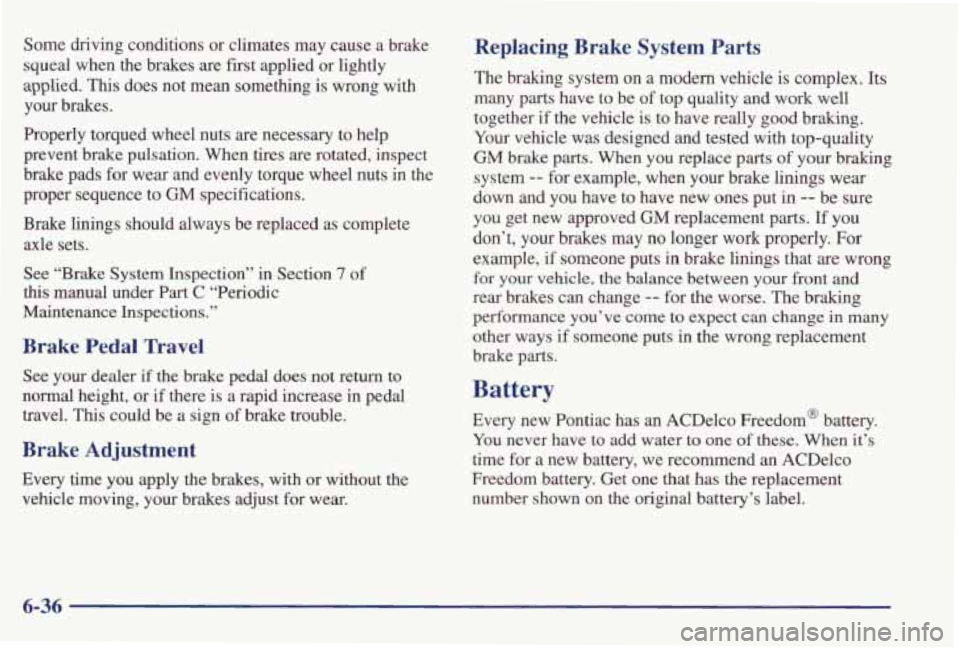
Some driving conditions or climates may cause a brake
squeal when the brakes are first applied or lightly
applied.
This does not mean something is wrong with
your brakes.
Properly torqued wheel nuts are necessary to help
prevent brake pulsation. When tires are rotated, inspect
brake pads for wear and evenly torque wheel nuts in the
proper sequence to GM specifications.
Brake linings should always be replaced as complete
axle sets.
See “Brake System Inspection” in Section
7 of
this manual under Part C “Periodic
Maintenance Inspections.”
Brake Pedal Travel
See your dealer if the brake pedal does not return to
normal height, or
if there is a rapid increase in pedal
travel.
This could be a sign of brake trouble.
Brake Adjustment
Every time you apply the brakes, with or without the
vehicle moving, your brakes adjust for wear.
Replacing Brake System Parts
The braking system on a modem vehicle is complex. Its
many parts have to
be of top quality and work well
together
if the vehicle is to have really good braking.
Your vehicle was designed and tested with top-quality
GM brake parts.
When you replace parts of your braking
system
-- for example, when your brake linings wear
down and you have to have new ones put in
-- be sure
you get new approved GM replacement parts. If you
don’t, your brakes
may no longer work properly. For
example, if someone puts in brake linings that are wrong
for your vehicle, the balance between your front and
rear brakes can change
-- for the worse. The braking
performance you’ve
come to expect can change in many
other ways if someone puts in the wrong replacement
brake parts.
Battery
Every new Pontiac has an ACDelco Freedom@ battery.
You never have to add water to one of these. When it’s
time for a
new battery, we recommend an ACDelco
Freedom battery. Get one that has the replacement
number shown on the original battery’s label.
6-36
Page 340 of 402

AUWCNSL CD CHG
ECM
CRUISE
UP-IGN
SIR
TURN
ABS
BTSI
PWR DROP HVAC CTRL
DIC/HVAC
DRL Auxiliary Power, Overhead Console
CD Changer
Underhood Electrical Center
-- Passenger’s Side
ECM
Cruise Control
ChimeNall Module, Cluster, Trip
Computer, Head-Up Display,
Brake-Transaxle Shift Interlock
Supplemental Inflatable Restraint
Turn Signal
(Air Bag)
Anti-Lock Brakes
PRNDL, Brake-Transaxle Shift Interlock
Power Drop Ignition
Blower Control, HVAC
Rear Defog, HVAC, Driver
Information Center, Daytime
Running Lamps, Heated Seats
Canister
Vent Solenoid
Daytime Running Lamps Some fuses are in a fuse block on the passenger’s side
of
the engine compartment. Pull
off the cover labeled
FUSES
to expose the fuses.
6-65
Page 350 of 402
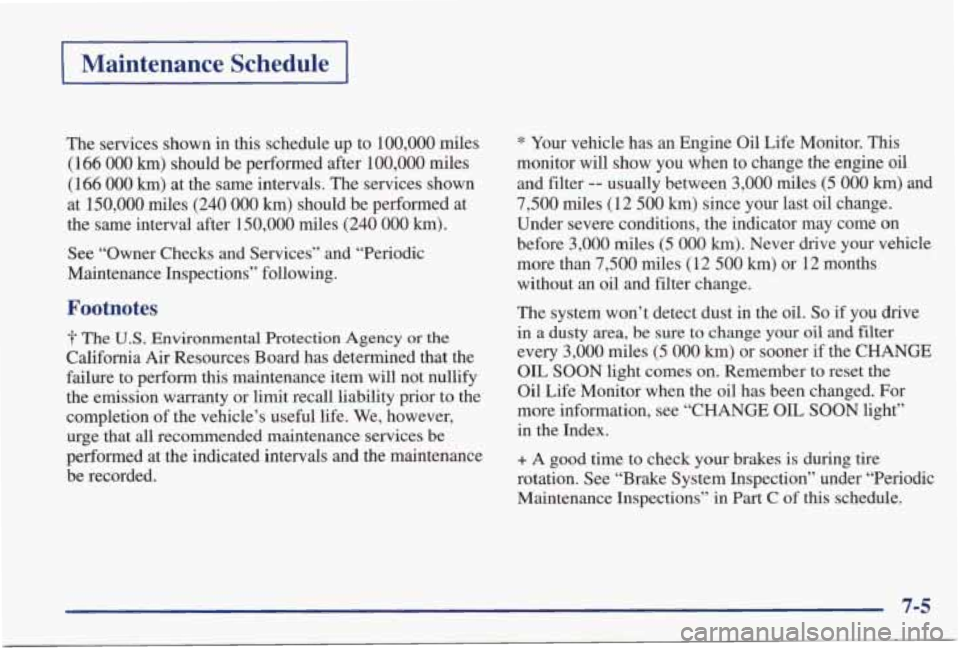
Maintenance Schedule
The services shown in this schedule up to 100,000 miles
(166
OOO km) should be performed after 100,000 miles
(166
000 km) at the same intervals. The services shown
at
150,000 miles (240 000 km) should be performed at
the same interval after 150,000 miles
(240 000 km).
See “Owner Checks and Services” and “Periodic
Maintenance Inspections” following.
Footnotes
? The US. Environmental Protection Agency or the
California Air Resources Board has determined that the
failure to perform
this maintenance item will not nullify
the emission warranty or limit recall liability prior
to the
completion
of the vehicle’s useful life. We, however,
urge that
all recommended maintenance services be
performed at the indicated intervals and the maintenance be recorded.
* Your vehicle has an Engine Oil Life Monitor. This
monitor will show you when to change the engine oil
and filter
-- usually between 3,000 miles (5 OOO km) and
7,500 miles (12 500 km) since your last oil change.
Under severe conditions, the indicator may come
on
before 3,000 miles (5 000 km). Never drive your vehicle
more than
7,500 miles (12 500 km) or 12 months
without
an oil and filter change.
The system won’t detect dust
in the oil. So if you drive
in
a dusty area, be sure to change your oil and filter
every 3,000 miles (5 000 km) or sooner if the CHANGE
OIL SOON light comes on. Remember to reset the
Oil Life Monitor when the oil has been changed. For
more information, see “CHANGE
OIL SOON light”
in the Index.
+ A good time to check your brakes is during tire
rotation. See “Brake System Inspection” under “Periodic
Maintenance Inspections”
in Part C of this schedule.
Page 362 of 402
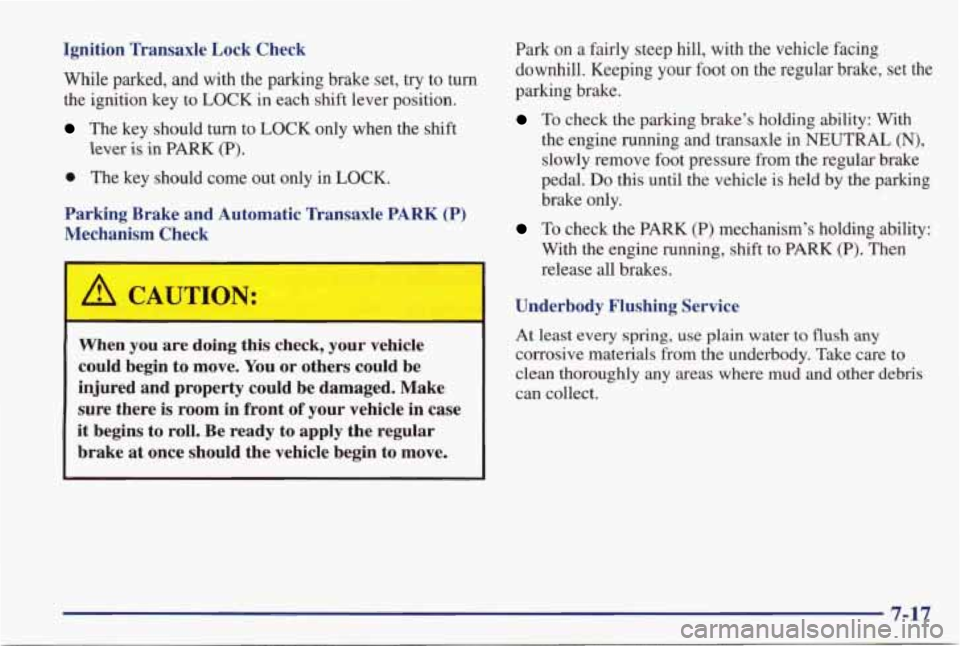
Ignition Transaxle Lock Check
While parked, and with the parking brake set,
try to turn
the ignition key to LOCK in each shift lever position.
The key should turn to LOCK only when the shift
lever is in PARK (P).
0 The key should come out only in LOCK.
Parking Brake and Automatic Transaxle PARK
(P)
Mechanism Check
1
Park on a fairly steep hill, with the vehicle facing
downhill. Keeping your foot on the regular brake, set the
parking brake.
To check the parking brake’s holding ability: With
the engine running and transaxle in
NEUTRAL (N),
slowly remove foot pressure from the regular brake
pedal. Do this until the vehicle is held by the parking
brake only.
To check the PARK (P) mechanism’s holding ability:
With the engine running, shift to
PARK (P). Then
release
all brakes.
Underbody Flushing Service
At
least every spring, use plain water to flush any
corrosive materials from the underbody. Take care to
clean thoroughly any areas where mud and other debris
When you are doing this check, your vehicle
could begin
to move. You or others could be
injured and property could be damaged. Make
it begins to roll. Be ready to apply the regular
sure there
is room in front of your
vehicle in case can collect.
brake
at once should the vehicle begin to move.
Page 363 of 402
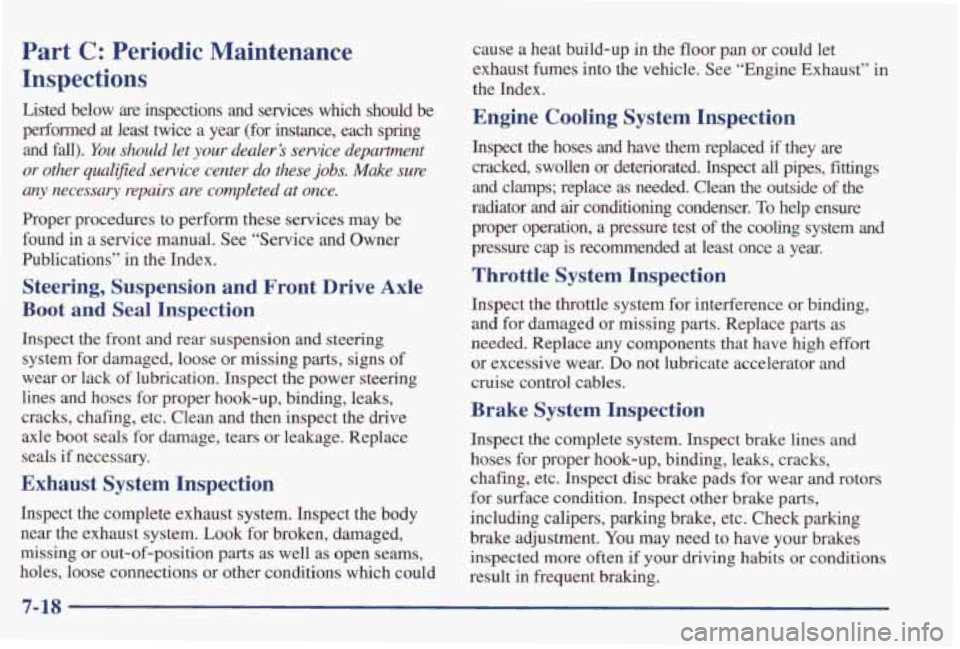
Part C: Periodic Maintenance
Inspections
Listed below are inspections and services which should be
perfunned at least twice a year (for instance, each spring
and
fall). You should let your dealer’s service department
or other qual$ed service center
do these jobs. Make sure
any necessary repairs are completed
at once.
Proper procedures to perform these services may be
found
in a service manual. See “Service and Owner
Publications” in the Index.
Steering, Suspension and Front Drive Axle
Boot
and Seal Inspection
Inspect the front and rear suspension and steering
system for damaged, loose or missing parts, signs of
wear or lack
of lubrication. Inspect the power steering
lines and hoses for proper hook-up, binding, leaks,
cracks, chafing, etc. Clean and then inspect the drive
axle boot seals for damage, tears or leakage. Replace
seals if necessary.
Exhaust System Inspection
Inspect the complete exhaust system. Inspect the body near the exhaust system. Look for broken, damaged,
missing or out-of-position parts
as well as open seams,
holes, loose connections or other conditions which could cause
a heat build-up in the floor pan or could let
exhaust fumes into the vehicle. See “Engine Exhaust’’ in
the Index.
Engine Cooling System Inspection
Inspect the hoses and have them replaced if they are
cracked, swollen or deteriorated. Inspect
all pipes, fittings
and clamps; replace
as needed. Clean the outside of the
radiator and
air conditioning condenser. To help ensure
proper
operation, a pressure test of the cooling system and
pressure cap is recommended at least once a year.
Throttle System Inspection
Inspect the throttle system for interference or binding,
and for damaged
or missing parts. Replace parts as
needed. Replace any components that have high
effort
or excessive wear. Do not lubricate accelerator and
cruise control cables.
Brake System Inspection
Inspect the complete system. Inspect brake lines and
hoses for proper hook-up, binding, leaks, cracks,
chafing, etc. Inspect disc brake pads for wear and rotors
for surface condition. Inspect other brake parts,
including calipers, parking brake, etc. Check parking
brake adjustment. You may need to have your brakes
inspected more often if your driving habits or conditions
result
in frequent braking.
7-18
Page 379 of 402

1998 PONTIAC SERVICE PUBLICATIONS ORDERING INFORMATION
The following publications covering the operation and servicing of your vehicle can be purchased by filling out
the Service Publication Order Form in this
book and mailing it in with your check, money order,
or credit card information to Helm, Incorporated (address below.)
CURRENT PUBLICATIONS FOR 1998 PONTIAC
SERVICE MANUALS
Service Manuals have the diagnosis and repair information
on engines, transmission, axle, suspension, brakes,
electrical, steering, body, etc.
RETAIL SELL PRICE: $90.00
TRANSMISSION, TRANSAXLE, TRANSFER CASE
UNIT REPAIR MANUAL
This manual provides information on unit repair service
procedures, adjustments and specifications for the
1998 GM transmissions, transaxles and transfer cases.
RETAIL SELL
PRICE: $40.00
SERVICE BULLETINS
Service Bulletins give technical service information needed
to knowledgeably service General Motors cars and trucks.
Each bulletin contains instructions to assist
in the
diagnosis and service of your vehicle.
PLEASE COMPLETE THE ORDER FORM SHOWN ON
THE FOLLOWING PAGE AND MAIL TO:
Helm, Incorporated RO. Box 07130 Detroit, MI 48207
OWNER’S INFORMATION
Owner publications are written directly for Owners and
intended to provide basic operational information about the
vehicle. The owner’s manual will include the Maintenance
Schedule for all models.
In-Portfolio: Includes a Portfolio, Owner’s Manual and
Warranty Booklet. RETAIL
SELL PRICE: $1 5.00
Without Portfolio: Owner’s Manual only.
RETAIL SELL PRICE: $1 0.00
CURRENT & PAST MODEL ORDER FORMS
Service Publications are available for current and past
model GM vehicles. To request an order form, please
specify year and model name of the vehicle.
OR ORDER TOLL FREE: 1-800-782-4356
Monday-Friday 8:OO AM - 6:OO PM Eastern lime
For Crdi Card Orders Only (VISA-MasterCard-Disr)
Page 382 of 402

Section 9 Index
Accessory Power outlet ......................... 2-58
Adding Equipment to the outside of Your Vehicle ...... 6-3
AirBag ....................................... 1-23
How it Works ................................ 1-24
Readiness Light ......................... 1.23. 2.67
Air Cleaner .................................... 6-20
Air Conditioning ............................ 3.3. 3.7
Air Conditioning Refrigerants ..................... 6-70
Alignment and Balance. Tire ...................... 6-50
Aluminum Wheels. Cleaning ...................... 6-57
Anti-Lock
Brake System Warning Light
................ 2.67. 4.9
Brakes ...................................... 4-7
Anti.Theft. Radio .............................. 3-27
Appearance Care ............................... 6-52
Appearance Care Materials Chart .................. 6-60
ArbitrationPro gram .............................. 8-9
Arming Confirmation ............................. 2-15
Arming with the Power Lock Switch ................ 2-14
Ashtrays and Lighter ............................ 2-57
Audio Controls. Steering Wheel ................... 3-29
Audio Equipment. Adding ........................ 3-30
Audio Systems ................................. 3-10
Arming with the Remote Keyless Entry Transmitter .... 2-15
Automatic
Auxiliary Temp Control
....................... 3-4
Doorhcks .............................. 2.6. 2.47
Check ...................................... 7-15
Fluid ....................................... 6-22
Operation ................................... 2-21
Park Mechanism Check ....................... 7-17
Backglass Antenna ............................. 3-21
With a Trailer ................................ 4.37
Battery ....................................... 6-36
Jump Starting ................................. 5-3
Replacement, Remote Keyless Entry .............. 2-10
Resynchronizing, Remote Keyless Entry ........... 2-11
Warnings ........................... 5-3,5-5, 6-37
Battery Replacement ............................ 2-10
BatterySaver .................................. 2-43
BBB Auto Line ................................. 8-9
Before leaving on a Long Trip ..................... 4-24
Better Business Bureau Mediation ......... ..... 8-9
Blizzard ............................. .... 4-29
9-1
Page 392 of 402
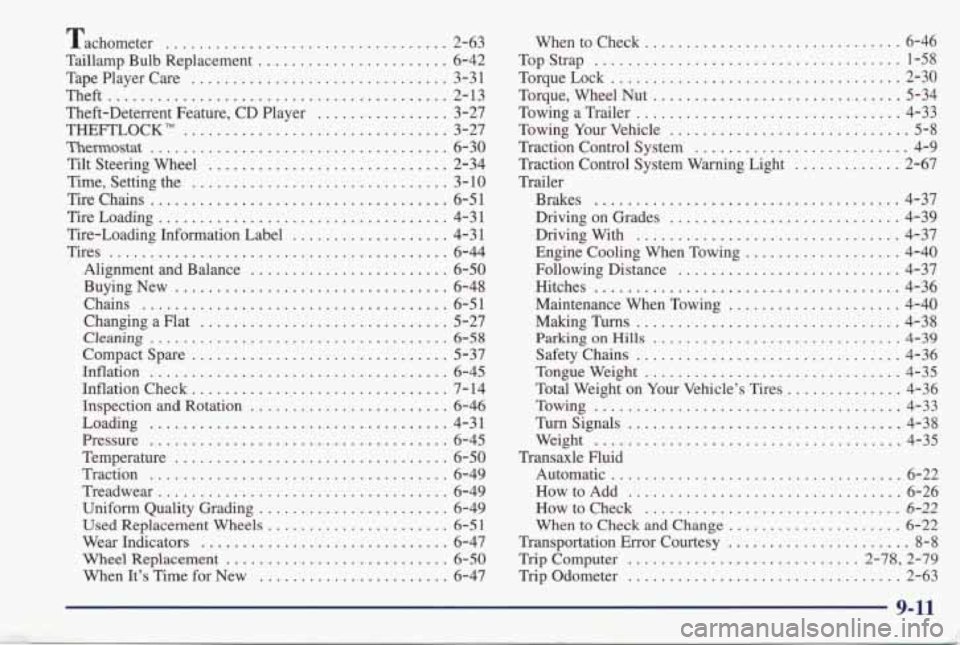
Tachometer ................................ 2-63
Taillamp Bulb Replacement
....................... 6-42
TapePlayerCare
............................... 3-31
Theft
......................................... 2-13
Theft-Deterrent Feature. CD Player
................ 3-27
THEFTLOCK”
................................ 3-27
Themostat .................................. 6-30
Tilt Steering Wheel
. . .................... 2-34
Time. Setting the
............................... 3-10
Tire Chains
.................................... 6-51
TireLoading ................................... 4-31
Tire-Loading Information Label
................... 4-3 1
Tires ......................................... 6-44
Alignment and Balance
........................ 6-50
BuyingNew
................................. 6-48
Chains
..................................... 6-51
Changing a Flat
.............................. 5-27
Cleaning .................................... 6-58
Compact Spare ............................... 5-37
Inflation
.................................... 6-45
Inflation Check
............................... 7-14
Inspection and Rotation
........................ 6-46
Loading
.................................... 4-31
Pressure
.................................... 6-45
Temperature
................................. 6-50
Traction
........................ ........ 6-49
Treadwear
................................... 6-49
Uniform Quality Grading
....................... 6-49
Used Replacement Wheels
...................... 6-51
Wear Indicators .............................. 6-47
Wheel Replacement ........................... 6-50
When It’s Time for New
....................... 6-47 When to Check
............................... 6-46
TopStrap
..................................... 1-58
Torque Lock ................................... 2-30
Torque. Wheel Nut
.............................. 5-34
Towing a Trailer
................................ 4-33
Towing Your Vehicle
............................. 5-8
Traction Control System
.......................... 4-9
Traction Control System Warning Light
............. 2-67
Trailer
Brakes
..................................... 4-37
Driving on Grades
............................ 4-39
Driving With
................................ 4-37
Engine Cooling When Towing
................... 4-40
Following Distance
........................... 4-37
Hitches
..................................... 4-36
Maintenance When Towing
..................... 4-40
MakingTurns
................................ 4-38
Parking on Hills .............................. 4-39
Safety Chains ................................ 4-36
Tongueweight
............................... 4-35
Total Weight on Your Vehicle’s Tires
.............. 4-36
Towing
..................................... 4-33
Turnsignals
................................. 4-38
Weight
..................................... 4-35
Automatic
............................... 6-22
HowtoAdd
................................. 6-26
How to Check
............................... 6-22
When to Check and Change ..................... 6-22
Transportation Error Courtesy ...................... 8-8
Trip Computer ............................ 2.78. 2.79
Trip Odometer
................................. 2-63
Transaxle Fluid
9-11